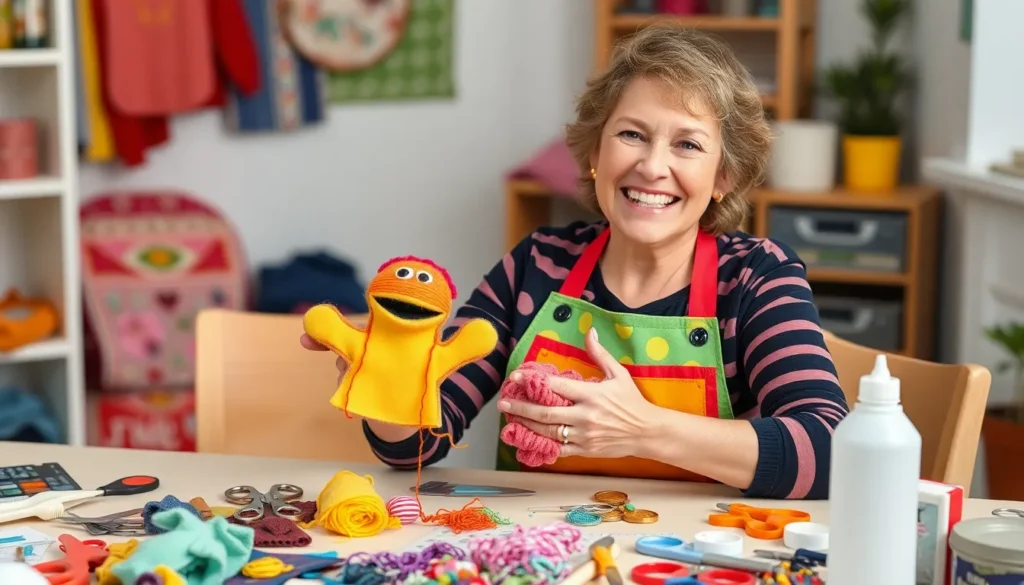Puppets aren’t just for kids’ shows or the occasional late-night comedy sketch. They’re a gateway to creativity, imagination, and a whole lot of fun! Whether it’s a quirky sock puppet or a sophisticated marionette, making puppets can unleash an inner artist that even a toddler with a crayon would envy.
Overview of Making Puppets
Making puppets involves various methods and materials that cater to different skill levels. The process can start with simple designs, such as sock puppets, which require minimal supplies. For these, a sock, some felt, and glue create a fun and engaging puppet, making it perfect for beginners.
Crafting more complex puppets includes marionettes and shadow puppets, often incorporating wood, strings, or even computer-generated images. Various types of puppets, from finger puppets to rod puppets, emphasize distinct crafting techniques and storytelling styles.
Choosing the right materials plays a crucial role in puppet making. Fabric remains a popular choice for soft puppets, while cardboard or paper often suits shadow puppets. Additionally, paints and markers help bring expressions and characters to life, allowing for personalized designs.
Techniques vary widely, ranging from sewing for fabric puppets to assembling with glue for paper crafts. Understanding basic puppet mechanics, such as controlling movements through string manipulation, adds an interactive element that captivates audiences.
The benefits of puppet making extend beyond creativity. It encourages hands-on learning, enhances fine motor skills, and develops storytelling abilities. Engaging in this craft at any age fosters collaboration and communication among individuals, making it an enjoyable group activity.
Overall, the art of making puppets offers endless possibilities for expression and connection. Whether for personal enjoyment or educational purposes, each puppet creation becomes a unique piece of art reflecting the maker’s vision.
Types of Puppets
Various types of puppets offer unique crafting experiences. Each type engages creativity in distinct ways.
Hand Puppets
Hand puppets, often called glove puppets, allow for direct manipulation by the puppeteer. Simple to make, they typically use a piece of fabric, a sock, or a constructed puppet body. Characters come to life through the movement of the puppeteer’s hand inside. Craftsmen can easily enhance these puppets with added features, such as sewn-on eyes or stitched mouths. Versatile in storytelling, hand puppets suit a range of performances, from simple kid’s tales to complex narratives for adults.
Shadow Puppets
Shadow puppets utilize backlighting to create captivating visual stories. Typically made from cardboard or stiff paper, these puppets generate shadow images against a screen. The technique relies on careful design to ensure clear outlines and engaging shapes. Light sources, such as lamps or projectors, bring the puppets to life as they cast shadows that dance across the backdrop. This form of puppetry encourages creativity, allowing makers to experiment with different shapes and movements, enhancing visual storytelling for audiences.
Materials for Making Puppets
Selecting materials for puppet creation influences the overall outcome and effectiveness of the puppets. Different types of materials cater to specific puppet styles and techniques.
Recyclable Materials
Cardboard, plastic bottles, and paper tubes offer excellent options for crafting puppets. Creators can transform discarded items into imaginative puppets, encouraging sustainability. Egg cartons shape into puppet bodies, while bottle caps serve as eyes or joints. This approach not only reduces waste but also enhances creativity. The use of recyclable materials promotes resourcefulness and adds unique character to each puppet. Additionally, these materials are accessible and inexpensive, making them suitable for various crafting projects.
Fabric and Textiles
Fabric and textiles provide versatility in puppet making. Cotton, felt, and old clothes easily transform into puppet bodies and limbs. Puppeteers often use different textures to create engaging looks. Sewing or gluing pieces together brings the puppet to life, while embellishments like buttons and yarn add detail. Soft puppets, such as sock puppets, highlight the charm of fabrics due to their approachable feel. Utilizing vibrant colors and patterns enhances visual appeal within storytelling. The choice of fabric directly impacts the finished puppet’s personality and style.
Techniques for Puppet Creation
Crafting puppets involves several essential techniques, which enhance creativity and functionality.
Designing Characters
Character design serves as the foundation for successful puppets. First, creators visualize personality traits, emotions, and stories that each puppet embodies. Next, sketches of these ideas come to life on paper or digital platforms. Diverse shapes and colors play a significant role in making characters appealing. Additionally, costume details, like hats or accessories, enhance uniqueness and character depth. Finally, drawing inspiration from various cultures or historical figures can enrich character design.
Assembling Parts
Assembling parts requires careful attention to detail. Makers gather all necessary materials, including fabric, cardboard, and glue, ensuring each piece fulfills its purpose. Connecting limbs or movable features comes next, often using sewing or glue methods for durability. Additionally, reinforcement with craft sticks or wire supports stability and enhances manipulation. Different assembly techniques can lead to distinct puppet styles. Each design choice affects the overall appearance and ease of use during performance.
Adding Mechanics
Adding mechanics transforms basic puppets into dynamic performers. Creators incorporate moving parts like rods for marionettes or strings for marionette operation. Puppeteers find that essential mechanisms dictate fluidity and control during performances. Consideration of weight distribution and balance plays an important role as well. Crafting mechanisms that capture audience attention can elevate storytelling and design. Understanding these mechanics leads to a more engaging and interactive puppet experience.
Tips for Successful Puppet Making
Selecting the right materials significantly impacts the puppet’s final appearance and functionality. Recyclable items such as cardboard, plastic bottles, and paper tubes provide an eco-friendly option for crafting. Fabric choices like cotton and felt add texture and vibrancy, allowing for creative expressions in puppet designs.
Planning the puppet’s character design enhances storytelling effectiveness. Sketching ideas that integrate diverse shapes, colors, and costume details creates unique personas. By focusing on personality traits, makers infuse puppets with life, contributing to captivating performances.
Attention to detail during assembly promotes durability and functionality. Strong gluing or careful sewing ensures that each puppet component remains intact through numerous performances. Organizing parts logically aids in effective puppet manipulation, facilitating smoother actions during shows.
Incorporating mechanics into puppet design adds liveliness. Employing moving parts gives puppets a dynamic quality, increasing engagement during performances. Understanding how mechanics work allows creators to control movements precisely, enriching storytelling experiences.
Experimenting with different techniques broadens creative horizons. Utilizing sewing, gluing, or even painting adds depth and detail to each puppet. Choosing the right technique based on skill level ensures a successful outcome, encouraging confidence in makers.
Lastly, collaboration fosters learning and innovation. Working with others encourages the sharing of ideas and techniques, enriching the puppet-making experience. Gaining perspective from different creators expands one’s approach to design and craftsmanship.
Conclusion
Puppet making opens a world of creativity and expression that transcends age and skill level. Each puppet crafted is not just a project but a unique storytelling medium that reflects the maker’s vision. By experimenting with various materials and techniques, creators can bring their imaginative characters to life, enriching their storytelling experiences.
The journey of puppet creation encourages hands-on learning and collaboration, fostering a sense of community among enthusiasts. Whether through simple sock puppets or intricate marionettes, the art of puppetry continues to inspire and connect people, making it a rewarding and enjoyable pursuit for all.















